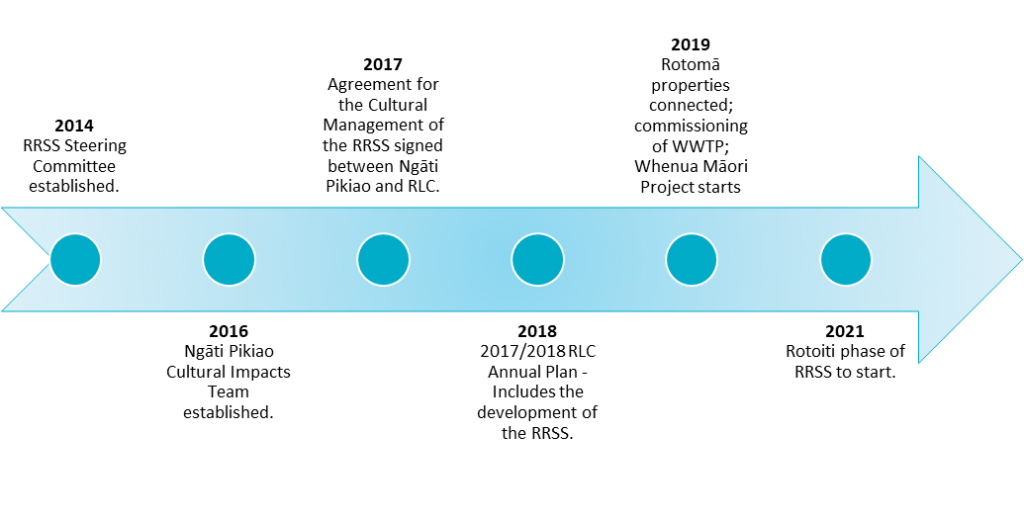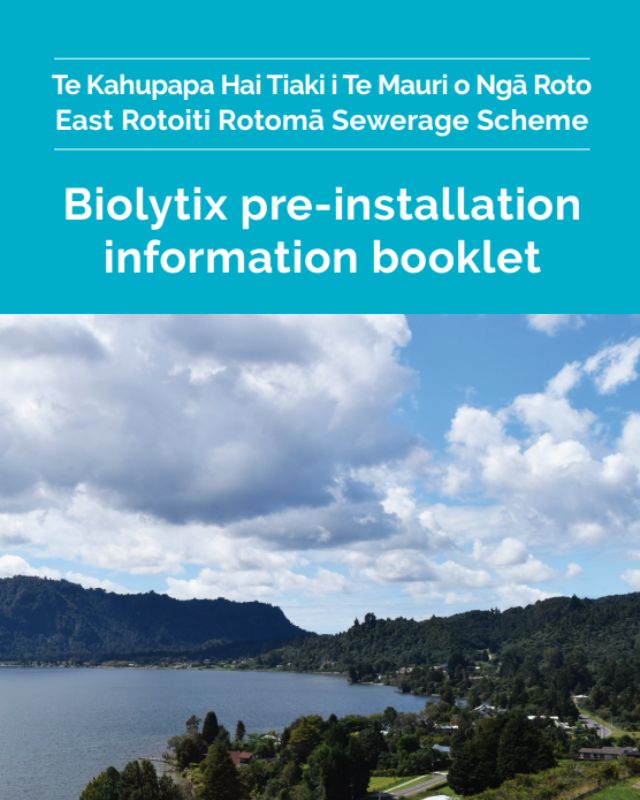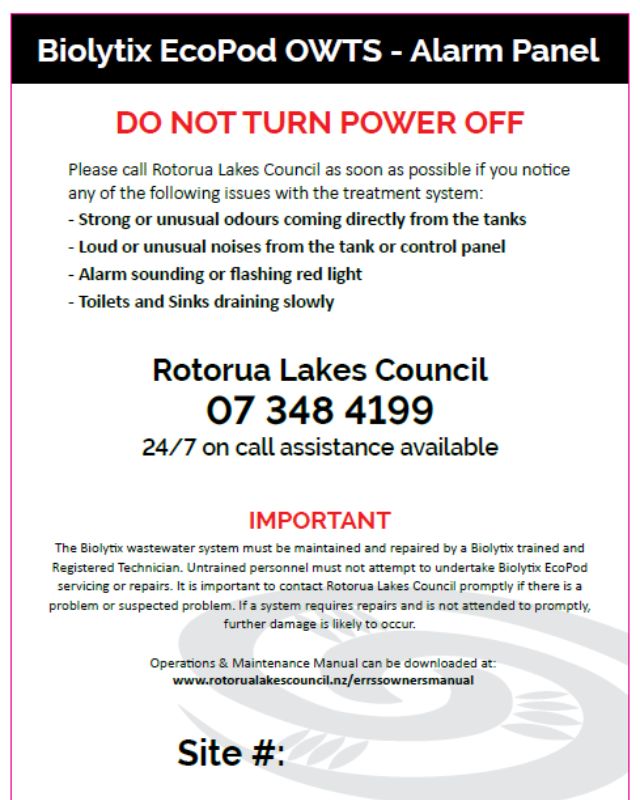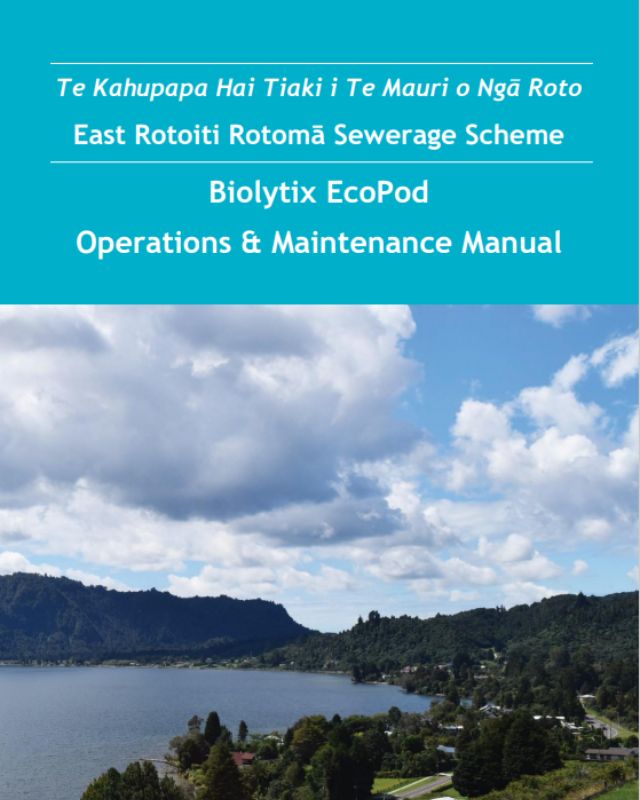East Rotoiti and Rotomā sewerage scheme
Capital repayment plan for properties connected to East Rotoiti Rotomā scheme
Payment of targeted rate for Rotoiti/Rotomā Sewerage Scheme
The 2024-2034 Long-term Plan was adopted by Council on 26 June 2024. Among decisions made was the introduction of a capital repayment plan for ratepayers with properties connected to the East Rotoiti/Rotomā sewerage scheme, effective 1 July 2024.
Notices will be sent out from 18 July notifying ratepayers of rates balances and payment options.
What amount will each property owner connected to the scheme pay?
The projected residents’ share per property or per connection = $19,553 (GST excl) or $22,486 (GST incl).
Where multiple systems are being connected, the property/ies will receive multiple capital charges reflecting the number of systems. Note: Generally residential properties will only have one system installed and one capital charge.
What is the subsidy that Rotorua Lakes Council will pay?
$2700 per household.
What are the options for payment?
Payment will be recovered by a rate against your property for the next 25 years. This will be done in quarterly instalments and included in your rates assessment and quarterly instalments notice. Alternatively, you may elect to repay this as a lump sum.
What happens to my existing direct debit for rates payments?
The capital rate is treated the same as all other rates such as rubbish collection and will be included in the direct debit payment.
What if I genuinely can’t afford the additional capital rate?
Council will assist ratepayers to utilise RLC’s rates remission policy. The rates notices contain information on Council’s remissions policy and Council staff are available to discuss options with ratepayers needing assistance.
What additional funding has been sought to fund the sewerage scheme?
Council has secured a $10m loan from the Ministry for the Environment which will be repaid over 10 years from the Lakes Enhancement rate.
The lakes are an asset for the entire Rotorua district. Why is this not reflected in the capital repayment scheme?
Additional project costs of $4.5m will be spread across the wider Rotorua district and recovered via the sewerage targeted rate, an increase of $15.50 per ratepayer per year.
If any additional funding commitment is secured, will RLC recalculate the cost to property owners?
Should future additional funding be secured towards the Scheme, Council could reset the rate to incorporate the additional external funding.
I am waiting to have a sewerage system installed. When do I have to start paying the capital rate?
The rate will not be charged to ratepayers who are yet to be connected but will be charged once the installation has occurred.
The East Rotoiti Rotomā Sewerage Scheme (the Scheme) aims to protect the health of the waterways, the health of the public, and to provide an essential service to the community. The scheme also aligns with the vision of the Rotorua Te Arawa lakes Programme (a partnership between Te Arawa Lakes Trust, Rotorua Lakes Council and the Bay of Plenty Regional Council):
‘to preserve and protect the lakes for the use and enjoyment of present and future generations while recognising and providing for the traditional relationship of Te Arawa with their ancestral lakes’
The project has come to fruition through a collaborative effort by Rotoiti/Rotomā Sewerage Steering Committee, Rotorua Lakes Council, Te Arawa Lakes Trust and Bay of Plenty Regional Council. The project has also been assisted through funding from the Ministry for the Environment and the Ministry of Health.
The Scheme will provide an essential service to approximately 680 households and has the capacity for future developments.
Protecting our lakes
Water quality has been declining in several Rotorua lakes, including lakes Rotoiti and Rotomā over a period of time and this is why organisations are now working together to help stop the rising nutrient levels.
For Rotoiti and Rotomā, domestic septic tanks contribute to the diminishing water quality as they are a source of pathogens and nutrients (nitrogen and phosphorus). One of the most effective ways to improve water quality (and protect the lakes) is to remove old septic tanks and replace them with a new system to collect human wastewater, reticulate (pipe) it to a wastewater plant where it can be treated and disposed of.
The East Rotoiti Rotomā Sewerage Scheme
The Scheme includes a wastewater treatment plant built behind the Rotoiti Emery Store, and a reticulation network that connects homes in Rotomā and East Rotoiti to the plant. Each property will have a preliminary on-site system that provides a high level of pre-treatment, a condition of the Resource Consent and Cultural Management Plan. This reduces the risk of para reaching waterways in the event of a breakage or damage to the pipes.

East Rotoiti Rotomā Sewerage Scheme project timeline
Who has been part of the project development?
Nā wai te hinonga i whakarite?
The project is a collaborative effort by Rotorua Lakes Council, Rotoiti/Rotomā Sewerage Steering Committee, Te Arawa Lakes Trust and Bay of Plenty Regional Council, with funding from the Ministry for the Environment and Ministry of Health.
Working with community and iwi to develop the Scheme
Over several years the community-led Rotoiti Rotomā Steering Committee (established in 2014) oversaw the decision making to identify the best onsite pre-treatment for installation on properties. At the core of the committee’s work were environmental, social, and cultural values. These values informed solutions to provide resilience in the technical aspects of the reticulation network and the wastewater treatment plant in everyday usage, as well as in the event of emergencies (e.g. earthquakes).
The project was also guided by the Ngāti Pikiao Cultural Impacts Team, who continue to provide specialist cultural and technical knowledge to the project. The team ensures that the recommendations of the two cultural impact assessments (one for the reticulation network, and one for the Haumingi 9B3B wastewater treatment plant site) are incorporated into the Council’s planning, design, construction and operation of the Scheme.
Rotorua Lakes Council continues to work in partnership with iwi to ensure effective engagement with mana whenua in the completion and ongoing management of the Scheme.
As a result of the community and iwi engagement, a Scheme has been agreed and includes:
- All properties in Rotomā and Rotoiti will have an on-site system that provides a high level of pre-treatment (this a condition of the Resource Consent and Cultural Management Plan).
- 47km of main pipes (reticulation) connecting homes to the treatment plant.
- A wastewater treatment plant (built behind the Rotoiti Emery Store, on land owned by Haumingi B93B). The treatment plant uses natural bacteria (to remove nutrients), a membrane bio reactor (to filter and remove more nutrients), Ultraviolet (UV) light (to disinfect in the same way that the sun does), and then irrigating to pumice soils (providing additional natural filtration and safe dispersal).
- 3 pumping stations, 2 flushing stations and 5 flow monitoring sites.
The process enables the disposal of wastewater in a way that is environmentally and culturally appropriate, and technically robust.
News updates
Whakahou kawepūrongo
March 2024 - East Rotoiti Rotomā Sewerage Scheme – community update - (PDF, 1.4MB)
December 2023 - East Rotoiti Rotomā Sewerage Scheme – community update - (PDF, 867KB)
September 2023 - East Rotoiti Rotomā Sewerage scheme – community update - (PDF, 665KB)
March 2023 - East Rotoiti Rotomā Sewerage Scheme – community update - (PDF, 4.5MB)
December 2022 - East Rotoiti Rotomā Sewerage Scheme – community update - (PDF, 1.5MB)
August 2022 - East Rotoiti Rotomā Sewerage Scheme – community update - (PDF, 1.2MB)
April 2022 - East Rotoiti Rotomā Sewerage Scheme update - (PDF, 1.4MB)
January 2022 - Open Day postponed - East Rotoiti Rotomā Sewerage Scheme - (PDF, 453KB)
December 2021 - East Rotoiti Rotomā Sewerage Scheme update - (PDF, 714KB)
4 October 2021 - Latest updates to East Rotoiti residents - (PDF, 676KB)
16 July 2021 - Latest update to East Rotoiti landowners - (PDF, 607KB)
Related information
View a fly through of the proposed East Rotoiti Rotomā reticulation network below:

Biolytix pre-installation information booklet - (PDF, 2.7MB)

Biolytix EcoPod replacement stickers – (PDF, 370KB)
View a video of how the Biolytix system works:
FAQs
Pātai Putuputu
How did the Rotoiti/Rotomā Sewerage Steering Committee pick a preferred option?
At the core of the committee’s work were environmental, social, and cultural values. These values informed solutions to provide resilience in the technical aspects of the reticulation network and the wastewater treatment plant in everyday usage, as well as in the event of emergencies (e.g. earthquakes).
What involvement has the Cultural Impact Team had in the scheme?
It provides specialist cultural and technical knowledge to the project. The team ensures that the recommendations of the two cultural impact assessments (one for the reticulation network, and one for the Haumingi 9B3B wastewater treatment plant site) are incorporated into the Council’s planning, design, construction and operation of the Scheme.
Where is the Wastewater Treatment Plant?
The plant is on land owned by Haumingi 9B 3B Incorporation, behind the Rotoiti Emery Store (1434 State Highway 30, Rotorua).
How does the Wastewater Treatment Plant work?
The treatment plant uses natural bacteria (to remove nutrients), a membrane bio reactor (to filter and remove more nutrients), Ultraviolet (UV) light (to disinfect in the same way that the sun does), and then irrigating to pumice soils (providing additional natural filtration and safe dispersal). The plant emulates the natural biological process of digesting waste and aims to reduce the impact of the environment.
What system is at Rotomā?
Properties at Rotomā have a STEP (Septic Tank Effluent Pump) system, which is an on-site wastewater pre-treatment system.
What wastewater pre-treatment system will be installed in Rotoiti?
There has been a thorough and robust process to select the system that best meets the required performance criteria including operational effectiveness, system safety, effluent performance, cultural alignment and long-term cost-effectiveness. The awarded system for East Rotoiti is Biolytix BF2. This is the system that also met the earlier trial criteria.
The Biolytix BF2 Eco Pod (system) is the approved on-site wastewater system for East Rotoiti. There will be one system installed per dwelling, and it will sit below the ground surface with an access cover above ground. It is connected to the electrical panel of the house. The system uses micro-organisms, and tiger worms, to break down organic material. This is a natural process that reduces any offensive odours from wastewater.
When wastewater enters the system, solid waste is separated from liquid using filter beds. Tiger worms and other organisms break down waste solids and convert them into liquid. The tiger worms live throughout the filter bed, naturally aerating it, and wastewater is broken down by microorganisms as it trickles through the filter bed. The treated wastewater is then pumped from the on-site system through the local reticulated network to the main Wastewater Treatment Plant on Haumingi 9B3B for final treatment and disinfection prior to discharge.
For more information about the system visit www.biolytix.com or contact Council on 07 348 4199 to speak to an engineer about how the process works.
Click the link to download the Biolytix pre-installation information booklet – (PDF, 2.7MB)
Why can’t I use a septic tank anymore?
Existing systems are leaching nutrients and pathogens to the waterways including Lake Rotoiti and Lake Rotomā. To protect the water quality of the lakes, Bay of Plenty Regional Council, Rotorua Lakes Council and Te Arawa Lakes Trust have agreed that a wastewater treatment system is a crucial project. Now that the wastewater treatment plant has been built, the Bay of Plenty Regional council requires all properties within the reticulated area to connect to the scheme.
How much will it cost?
Council remains very aware that the final cost is a concern for residents and it is important to note that every effort has been made to constrain final costs.
There will be a capital contribution from landowners for the system. This capital contribution won’t need to be paid until the scheme is completed (under current Council decisions) and the full, actual costs are settled. This will likely be in two years’ time (2023).
All scheme participants will pay the same charge (except some community facilities such as schools, marae and sports clubs due to their importance to the community). Council’s advice is that it will continue to pursue the goal that the lowest possible net costs are achieved for the local ratepayers.
What are the payment options?
The payment options are:
- a lump sum paid once the scheme is complete (likely 2023), or
- instalments paid over 25 years as will be agreed by Council in due course) added each year to rates.
Hardship assistance is available through council for anyone unable to meet the cost. This will be assessed on an individual basis.
Owners may also qualify for a Rates Rebate. Click the link to read more about Rates Rebates or call 07 348 4199 to talk to our Customer Centre team.
What does it mean if you choose to pay in instalments?
This option incurs interest each year.
Are there other costs?
There will also be an annual operating cost per annum, which is equalised across Rotorua district to all properties connected to a wastewater scheme. This operating cost covers maintenance, repairs and system renewals.
Ngā Whenua Kahupapa Hai Tiaki i ngā Rotomoana
Rotorua Lakes Council is now looking for approval from landowners to install pipes required to connect properties to the new treatment plant. RLC held three hui-ā-hapū with Māori land owners and trustees in October 2020.
Click the following link to read more


